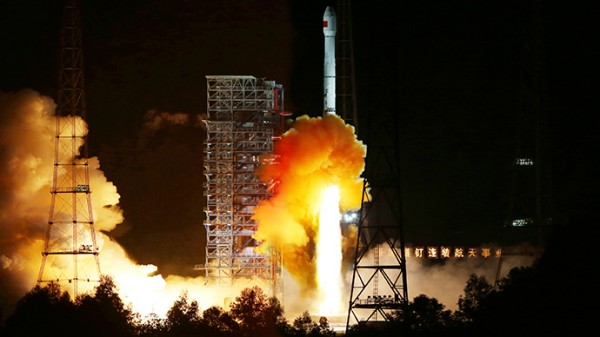China Will Use Pollutant-Free Rocket Fuel Starting 2015
| Ana Verayo | | Dec 11, 2014 09:37 AM EST |
(Photo : Reuters / Stringer) Long March 3C, carrying an experimental spacecraft, lifts off from the launch pad at the Xichang Satellite Launch Center, Sichuan province, October 24, 2014.
As part of China's ambitious space program goals, including building a manned space station by 2022, its next generation carrier rockets will use pollutant-free propellants starting 2015, according to a top state space scientist.
According to Lei Fanpei who is the chairman of the China Aerospace Science and Technology Corporation, their future rockets will be utilizing fuels that are a combination of liquid oxygen and diesel along with liquid oxygen and liquid hydrogen within the next two years.
Like Us on Facebook
These will include the Long March-5 and a smaller Long March-7 carrier rockets that will take some 15 years to apply these changes to all the Long March rocket technology.
The Long March-5 will possess a payload capacity of 25 tons that can carry capsules and spacecrafts at lower Earth orbit. However, it can also carry 14 tons during a cargo transfer in orbit which is twice the capacity of other current spacecrafts that could be a worthy contender to NASA's Delta-4H rocket.
When the planned space station is up and running by 2022, the Long March-7 can transport 13.5 tons of scientific payload where its first test flight is slated for next year.
Last Sunday, the CBERS-4 satellite was successfully launched via a Long March booster rocket where its primary mission is to monitor, plan and manage land from space and also for forestry, water conservation efforts including environmental protection and extended agriculture.
China has been utilizing Long March rocket technology since April 1970 where China's first satellite, Dongfanghong-1 was successfully launched into space on top of a Long March booster rocket. The CBERS-4 marks the 200th spaceflight mission using the Long March rocket.
Long March carrier rockets were first developed and conceived in 1956 where they have become the main carriers of China's satellites and spacecraft launches. To date, there are 250 space missions that have already been successfully catapulted into space.
According to Lei Fanpei, Long March rockets will continue to launch 100 more space missions in the next seven years.
Out of the first 100 rocket launches, only seven of them were failures. During the next 100 launches that started in 2007, the failure count has been minimized to only two which has proven to be the best space safety record when it comes to mission launches as opposed to U.S. and Russia.
TagsCBERS-4, long march rockets, china space missions, china mars mission, Mars, chinese rover on mars, pollutant free rocket fuel, China Will Use Pollutant-Free Rocket Fuel Starting 2015
©2015 Chinatopix All rights reserved. Do not reproduce without permission
EDITOR'S PICKS
-

Did the Trump administration just announce plans for a trade war with ‘hostile’ China and Russia?
-

US Senate passes Taiwan travel bill slammed by China
-

As Yan Sihong’s family grieves, here are other Chinese students who went missing abroad. Some have never been found
-

Beijing blasts Western critics who ‘smear China’ with the term sharp power
-

China Envoy Seeks to Defuse Tensions With U.S. as a Trade War Brews
-

Singapore's Deputy PM Provides Bitcoin Vote of Confidence Amid China's Blanket Bans
-

China warns investors over risks in overseas virtual currency trading
-

Chinese government most trustworthy: survey
-

Kashima Antlers On Course For Back-To-Back Titles
MOST POPULAR
LATEST NEWS
Zhou Yongkang: China's Former Security Chief Sentenced to Life in Prison

China's former Chief of the Ministry of Public Security, Zhou Yongkang, has been given a life sentence after he was found guilty of abusing his office, bribery and deliberately ... Full Article
TRENDING STORY

China Pork Prices Expected to Stabilize As The Supplies Recover

Elephone P9000 Smartphone is now on Sale on Amazon India

There's a Big Chance Cliffhangers Won't Still Be Resolved When Grey's Anatomy Season 13 Returns

Supreme Court Ruled on Samsung vs Apple Dispute for Patent Infringement

Microsoft Surface Pro 5 Rumors and Release Date: What is the Latest?










